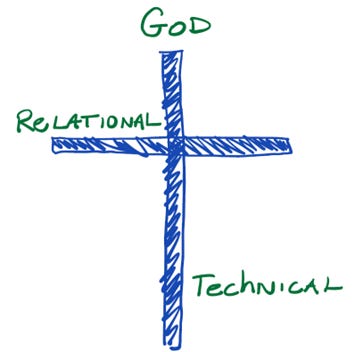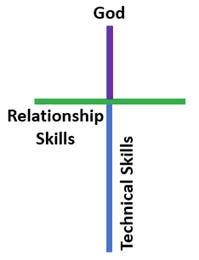The Shape is the Key
Post 2
In the first post, I shared a story that shaped me. In this one, I want to share the story that shaped this Substack—and the book behind it. It’s the story of how the t-shaped engineer came to be, and how a quiet theological correction helped me see its deeper truth.
The t-shaped Engineer
I’d like to tell you the story of how the t-shaped engineer came to be.
For over a decade, I had championed an approach to engineering education focused on producing T-shaped engineers—those with technical depth and strong professional skills: ethics, grit, motivation, communication. It was a model that made sense. It worked. And I believed in it.
Then, I got a call that would change the direction of my entire professional life. LeTourneau University was looking for a Dean of Engineering. I wasn’t looking – I had worked a great deal on personal contentment as a life skill, and was reasonably happy in my current role at another University. But the call intrigued me, and as I learned more about LeTourneau, I became more excited.
Then, I read Steve Mason’s white paper – it defined LeTourneau as The Christian Polytechnic University, laying out a saga for the institution and a vision for who they were and what they could be. I was hooked. I saw also how the T-shaped engineer that I had been working with could evolve based on my faith. How Jesus’s greatest commandment – To Love God and Love people, translated seamlessly into a better, fuller model – a lower cased t.
the t-shaped Engineer
The lower vertical represents a technical foundation. The horizontal cross piece recasts professional or soft skills into relational ones that help us connect with other people. And the upper vertical points toward God, centering Him as our ultimate purpose.
I developed this in preparation for the job interview. I got the job (best interview I ever had!). Soon after, I visited with my new boss and Provost excited to begin the work of focusing the engineering group around the t-shaped engineer concept. They were already doing this work – but naming it in such a simple and powerful way could help intentionalize our pursuits, giving them vision, power and resonance. Or so I thought then – and still do today.
My boss, a wise man, said, “Sounds wonderful Mike, but why don’t you run it by the theology Department before we get too excited – make sure its Biblical.” I was a little puzzled, and perhaps my enthusiasm was a bit dampened, but off I went to visit with one of the theology professors.
I sat in his office, still excited, and told him about this thing called the t-shaped engineer. He listened, thought for a moment, and then said, “I’m sorry, no, that doesn’t work. We can’t do that.”
What?
I was confused, a little miffed, perhaps also a bit nervous. This was one of the centerpieces of the vision I was casting in my new role.
He paused, then continued. He said, God is in all good things. All of them. You can’t push Him ‘up there,’ or ‘Over there.’ You can’t separate Him out. He isn’t bolted on or extra. If there are good things in your technical depth, He’s there. If there are good things in the relational aspects of your model, He’s there too. If it is good, it starts with Him.”
I was floored, and my wonderful Theology colleague was right.
This is in fact one potential ‘failure mode’ for the t-shaped engineer as a concept. But I did push back a little with something that I think my Theology friend really appreciated.
“Don’t you think that the overall shape gives it away?” I asked. The model is intentionally cross shaped, and that shape leads us to the point that God is central in all of it. He’s in every part. The shape itself points to Him directly.
My colleague paused, thought and said “You’re absolutely right, how about I add this to my theology class this fall?”
That’s the story of how the t-shaped engineer came to be accepted at my institution. Initially through a quiet conversation, and a humble Theology professor who invited me in to a learning moment. That conversation didn’t just affirm the model—it deepened it. It reminded me that the shape itself is a theological claim. It led to publishing several articles about it, and ultimately to my working on the forthcoming book – “The t-shaped Engineer in the Age of AI.” Since the book and this Substack are simply attempts to describe how to inculcate t-shaped skills and attributes in engineering graduates, a brief description of the t-shaped model is given here – we’ll come back to these concepts across many of the forthcoming posts on this channel. The lower part of the “t” represents technical skills such as thermodynamics, nodal analysis of circuits, fluid mechanics and static equilibrium. The cross piece represents softer skills – like leading, following, communicating, grit, drive, and conflict resolution. Skills that help us build relationships and connect to other people. The upper portion of the “t” represents that God is above all, ensuring we answer “What would God have us do? Is this good for human flourishing?”, and even, “Is this beautiful?” And finally, the overall cross shape reminds us that He truly is in all. In an age shaped by AI and digital acceleration, this model offers a way to form engineers who are not only competent, but wise—who know how to build, relate, and discern.
the t-shaped model in formal wear
The t-shaped model is not perfect. Like any framework, it can be misunderstood or misapplied. One of its greatest risks is the temptation to compartmentalize God—to treat Him as an add-on rather than the source of all good things. So let me leave you with two questions:
1. Do you see this tendency in your own life—to separate God from your work, your thinking, your passions?
2. Are there other ways you see this approach to engineering vocation breaking down—or being misunderstood?




